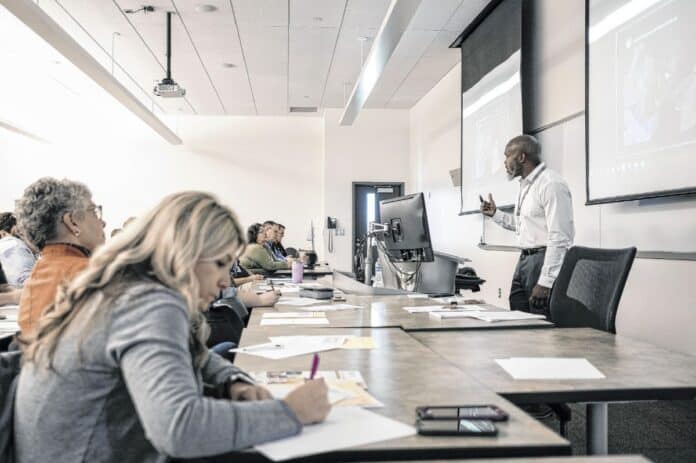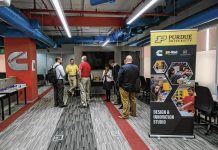
Implicit bias is everywhere, says Columbus East High School Assistant Principal Charles Edwards.
It’s in the classroom. It’s in the workplace. It’s in the grocery store. It’s in movies. It’s on the basketball court.
Several years ago as a teacher in Ohio, Edwards can recall a moment when he was the target of implicit bias among his coworkers. It played out on the basketball court when he was invited for the first time to play a pick-up game during a snow day with a group of fellow teachers.
“I’m horrible at basketball. I’m terrible. I really am,” Edwards said. “I can grab a couple rebounds. I can pass well, but that’s about it.”
[sc:text-divider text-divider-title=”Story continues below gallery” ]Click here to purchase photos from this gallery
Nevertheless, he was the first guy picked to join one of the two teams.
“I’m thinking to myself, ‘Jokes on you.’ Maybe they picked me because they knew I was from Indiana,” Edwards said. “Why did they really pick me?”
The Summerville Meeting Room at the Columbus Learning Center was silent, all 60 seats filled by local educators, mental health specialists and youth workers.
“Oh, somebody say it,” Edwards encouraged the audience to respond. “Because I’m black. All black people can play basketball.”
In front of a sold-out audience Friday, Edwards took attendees on a journey of overcoming implicit bias — first, defining implicit bias, then recognizing how implicit bias can affect an individual’s decision making and ultimately understanding how implicit bias can affect youth-serving systems and organizations.
Venturing outside
a sector
Three times a year, the Indiana Youth Institute and Council for Youth Development Bartholomew County partner with a local youth-serving organization to host a Youth Worker Cafe where community members can venture outside of their sectors and learn from each other.
Friday’s event, hosted in partnership with Bartholomew Consolidated School Corp., was designed to help local youth workers recognize their own biases and identify ways to minimize and eliminate decision-making that contributes to disparities based on race, ethnicity, gender and geography.
“We all work with kids and sometimes for whatever reason unknown to us, people are hard to love sometimes.” Edwards said. “We don’t know why. We can’t pick and choose how we extend relationships to kids. We gotta love them all and work with them all and try to move them all forward.”
In his presentation, titled “How We Do What We Do,” Edwards asked participants to talk among each other about what they first notice about a person. After a brief one-on-one discussion, participants shouted out their answers in front of the group.
“Whether they’re male or female.”
“Hygiene.”
“What they’re wearing.”
“Their eyes — eyes never lie.”
Edwards then asked them to consider what they know about implicit bias. Responses like “assumptions,” “unintentional” and “subconscious” were shouted out.
“We all have snap judgements, and we don’t know we’re doing it,” Edwards said. “Implicit bias doesn’t make you a bad person. But if we don’t address it, it can become dangerous. It can lead to discrimination which could lead to prejudice.”
A pop culture example
Using various pop culture examples including a clip from “National Lampoon’s Vacation,” Edwards proved just how implicit that implicit bias can be.
In the clip, the famed Clark Griswold drives the family’s station wagon through a Mississippi neighborhood after failing to follow the directions. As one audience member pointed out, just by listening to the jazz music in the scene, it’s obvious they’re in an urban neighborhood.
When a loud sound blasts and a female voice screams, the Griswolds quickly assume it’s a gunshot and roll up their windows. One viewer points out that when Clark Griswold tells his family, “See all this blight?” the film contrasts the Griswold’s quality of life with that of the people in the neighborhood.
“Where does implicit bias come from?” Edwards said. “It comes from background, personal experiences, the cultural environments we grow up in. Maybe we’ve got to slow down our thinking, we’ve got to stop and really analyze what’s driving our behavior.”
Applying these principles to the classroom or wherever else an individual may interact with a child, Edwards said it’s necessary to stop and understand what’s contributing to those inner judgements getting in the way of extending a relationship to someone.
“For us, it’s necessary because it’s the right thing to do. Period,” Edwards said. “We need to give as many students as possible the best chance they can have at success after they leave us. Whether that be in school-to-work, going right into the workforce, college, trade school or the military, we need to equip that kid to succeed.”
Starting a conversation
Heather Carson, director of Council for Youth Bartholomew County, said the organization’s philosophy with the youth worker cafe session is to start the conversation in the community.
“For implicit bias, we felt we knew it was something that those that serve and support youth probably would benefit from additional information and understanding and knowledge,” Carson said.
“First is recognizing and understanding on an intellectual level what implicit bias really is. Sometimes there’s different phrases that we really don’t unpack until we have a minute to gather together and have a better conversation.”
She said this conversation is a first step professionally. She hopes to create a roundtable discussion with Edwards in the future to lead a deeper discussion about what implicit bias means to each person individually.
“There are buzz words, but the reality is the meaning and importance behind those words; we need to unpack and then apply it in our own lives,” Carson said.
So back to the basketball court. Sure, Edwards was chosen by his teammates because he’s black, he said. But what bias lay behind that choice?
“All they know or all they’ve been taught or all they’ve seen or something in their past has made an imprint on them — all black people can play basketball,” Edwards said. “That was the only day I was picked first. We all come to every experience as we are. We leave no part of our identity behind.”
[sc:pullout-title pullout-title=”What is implicit bias?” ][sc:pullout-text-begin]
Implicit bias refers to the attitudes or stereotypes that affect our understanding, actions and decisions in an unconscious manner.
Source: Kirwan Institute for the Study of Race and Ethnicity at Ohio State University
[sc:pullout-text-end][sc:pullout-title pullout-title=”Where to learn more” ][sc:pullout-text-begin]
To learn more about Indiana Youth Institute and Council for Youth Development Bartholomew County’s initiatives, visit iyi.org and cydbartholomew.org.
[sc:pullout-text-end]




